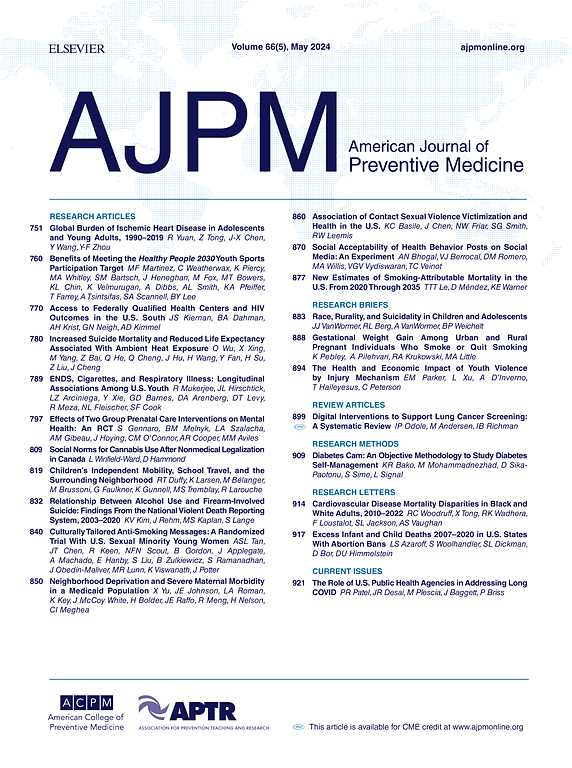国家因素如何缓和2021年儿童税收抵免对心理健康和经济困难的影响。
IF 4.5
2区 医学
Q1 MEDICINE, GENERAL & INTERNAL
引用次数: 0
摘要
导读:经济政策在一定程度上缓解了美国新冠肺炎大流行期间的心理健康问题。例如,2021年扩大的儿童税收抵免(CTC)为许多家庭提供了现金支持,并改善了心理健康。虽然反恐中心是一项联邦政策,但根据各州的情况,政策影响可能存在地理差异。本研究考察了状态因素如何改变CTC的影响。方法:本研究使用2021年4月至2022年1月来自人口普查住户脉搏调查的个人数据(N=944,189)。结果包括抑郁症状、焦虑症状、最近使用心理健康咨询和经济困难。州一级的修饰词包括(1)社会安全网政策背景(作为综合措施和个别政策)和(2)种族平等。本研究采用准实验的差异中差异中差异的方法,比较了符合条件的个体和不符合条件的个体的前后差异,考察了国家层面的因素是否调节了CTC扩张的影响。分析在2023-2025年期间进行。结果:综合国家安全网政策措施和种族平等指数对CTC没有影响。然而,在审查个别政策措施时,在WIC案件数量较高的州,CTC的扩大与支付租金/抵押贷款能力的信心提高有关。在SNAP可及性较高的州,CTC的扩大与食物不足减少和精神卫生服务利用率降低有关。结论:2021年联邦CTC的影响受到地方州政策背景的适度调节,可能导致地理健康差异。这为政策制定和多层次政策相互作用的研究提供了信息。本文章由计算机程序翻译,如有差异,请以英文原文为准。
How State Factors Moderated the Impacts of the 2021 Child Tax Credit on Mental Health and Financial Hardship
Introduction
Mental health problems during the COVID-19 pandemic in the U.S. were partly alleviated by economic policies. For example, the 2021 expansion of the child tax credit provided cash support to many families and improved mental health. Although the child tax credit was a federal policy, there may be geographic disparities in policy impacts depending on state contexts. This study examined how state factors modified the child tax credit’s effects.
Methods
This study used April 2021–January 2022 individual-level data from the Census Household Pulse Survey (N=944,189). Outcomes included depressive symptoms, anxiety symptoms, recent utilization of mental health counseling, and financial hardship. State-level modifiers included (1) social safety net policy context (as a composite measure and for individual policies) and (2) racial equity. This study examined whether state-level factors moderated the effects of the child tax credit expansion using a quasi-experimental difference-in-difference-in-differences approach, comparing pre–post differences among child tax credit–eligible versus ineligible individuals. Analyses were conducted during 2023–2025.
Results
There was no effect modification of the child tax credit by the composite state safety net policy measure or racial equity index. However, when examining individual policy measures, in states with higher Special Supplemental Nutrition Program for Women, Infants, and Children caseloads, the child tax credit expansion was associated with improved confidence in the ability to pay rent/mortgage. In states with higher Supplemental Nutrition Assistance Program accessibility, the child tax credit expansion was associated with reduced food insufficiency and lower utilization of mental health services.
Conclusion
The 2021 federal child tax credit’s effects were modestly moderated by local state policy contexts, potentially contributing to geographic health disparities. This informs policymaking and research on multilevel policy interactions.
求助全文
通过发布文献求助,成功后即可免费获取论文全文。
去求助
来源期刊

American Journal of Preventive Medicine
医学-公共卫生、环境卫生与职业卫生
CiteScore
8.60
自引率
1.80%
发文量
395
审稿时长
32 days
期刊介绍:
The American Journal of Preventive Medicine is the official journal of the American College of Preventive Medicine and the Association for Prevention Teaching and Research. It publishes articles in the areas of prevention research, teaching, practice and policy. Original research is published on interventions aimed at the prevention of chronic and acute disease and the promotion of individual and community health.
Of particular emphasis are papers that address the primary and secondary prevention of important clinical, behavioral and public health issues such as injury and violence, infectious disease, women''s health, smoking, sedentary behaviors and physical activity, nutrition, diabetes, obesity, and substance use disorders. Papers also address educational initiatives aimed at improving the ability of health professionals to provide effective clinical prevention and public health services. Papers on health services research pertinent to prevention and public health are also published. The journal also publishes official policy statements from the two co-sponsoring organizations, review articles, media reviews, and editorials. Finally, the journal periodically publishes supplements and special theme issues devoted to areas of current interest to the prevention community.
 求助内容:
求助内容: 应助结果提醒方式:
应助结果提醒方式:


